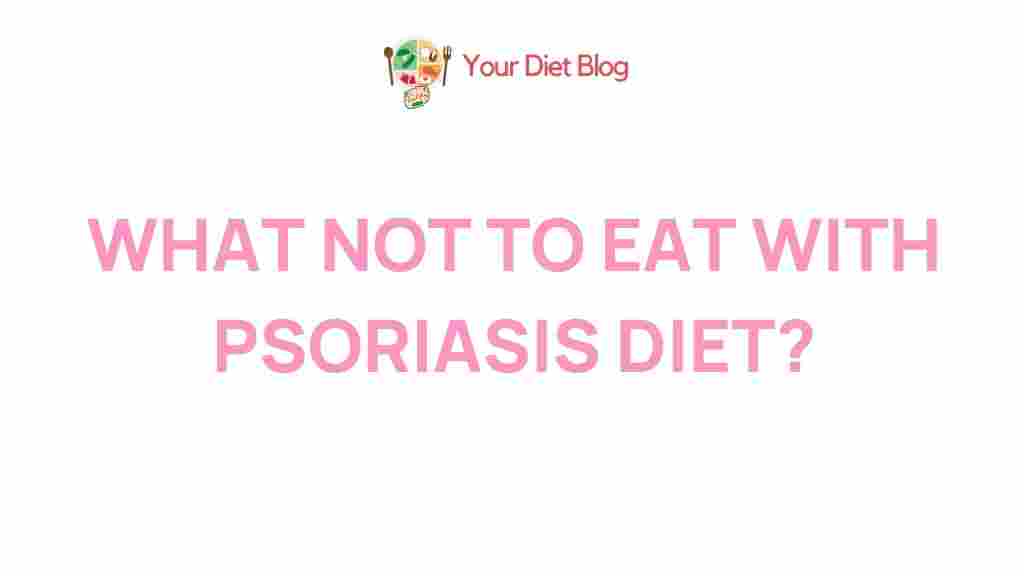Understanding the Psoriasis Diet: Foods to Avoid
Psoriasis is a chronic skin condition that can be triggered or worsened by certain dietary choices. While there’s no definitive cure, following a psoriasis diet tailored to your needs can significantly alleviate symptoms. Surprisingly, some seemingly harmless foods can worsen the condition, causing flare-ups or prolonged discomfort.
In this article, we’ll explore the surprising foods you should avoid if you’re managing psoriasis. Whether you’re newly diagnosed or looking to fine-tune your diet, this guide will provide actionable insights for maintaining healthier skin.
Why Diet Matters in Psoriasis Management
Psoriasis is an autoimmune condition that causes skin cells to build up rapidly, leading to scaling, inflammation, and redness. Although genetic and environmental factors play a role, diet is increasingly recognized as a contributing factor to symptom management.
Certain foods can trigger inflammation, disrupt the immune system, or aggravate the skin barrier. By avoiding these foods and adopting a psoriasis-friendly diet, you may reduce flare-ups and improve your quality of life.
The Role of Inflammatory Foods
Inflammation is a key driver of psoriasis symptoms. Foods that promote inflammation can intensify flare-ups, making it essential to identify and eliminate these triggers. A comprehensive psoriasis diet focuses on reducing inflammatory foods and incorporating anti-inflammatory alternatives.
Surprising Foods to Avoid on a Psoriasis Diet
While some dietary triggers are well-known, others might surprise you. Here’s a detailed look at the foods to avoid and why they could be worsening your psoriasis.
1. Nightshade Vegetables
Nightshades like tomatoes, potatoes, eggplants, and peppers are common in many diets but may not be ideal for those with psoriasis. These vegetables contain solanine, a compound that can exacerbate inflammation in sensitive individuals.
- Alternative: Opt for non-nightshade vegetables like broccoli, spinach, and zucchini.
2. Processed and Sugary Foods
Highly processed foods and those loaded with sugar are inflammatory by nature. They can spike blood sugar levels, leading to increased insulin production and inflammation, both of which aggravate psoriasis.
- Examples: Sweets, soft drinks, packaged snacks, and white bread.
- Alternative: Choose whole grains, natural sweeteners like honey, and fresh fruits for a balanced diet.
3. Red Meat and Fatty Cuts
Red meat, particularly fatty cuts, is high in saturated fats and arachidonic acid, a compound linked to skin inflammation. Consuming too much red meat can exacerbate symptoms and trigger flare-ups.
- Alternative: Lean protein sources such as chicken, turkey, or plant-based options like lentils and beans.
4. Dairy Products
Dairy is another potential trigger due to its inflammatory properties and high levels of saturated fats. For some, it may also contribute to increased mucus production, further exacerbating symptoms.
- Examples: Milk, cheese, and butter.
- Alternative: Swap dairy for almond milk, coconut yogurt, or other plant-based options.
5. Alcohol
Alcohol can interfere with the immune system and promote inflammation. Studies have shown that excessive alcohol consumption may worsen psoriasis symptoms and reduce the effectiveness of treatments.
- Alternative: Stick to water, herbal teas, or non-alcoholic beverages to stay hydrated and support skin health.
6. Gluten
Although the link between gluten and psoriasis is still being studied, many patients report improvement in symptoms after adopting a gluten-free diet. Those with a sensitivity or intolerance may experience heightened inflammation due to gluten.
- Examples: Bread, pasta, and other wheat-based products.
- Alternative: Choose gluten-free grains like quinoa, buckwheat, and rice.
Troubleshooting Your Psoriasis Diet
Transitioning to a psoriasis-friendly diet can be challenging, especially when eliminating favorite foods. Here are some tips to make the process easier:
- Start Slowly: Gradually reduce trigger foods rather than eliminating them all at once.
- Keep a Food Diary: Track your meals and symptoms to identify specific triggers.
- Seek Professional Guidance: Consult a dermatologist or dietitian for personalized advice.
For more tips on managing psoriasis symptoms, check out our comprehensive guide to skincare routines.
Incorporating Anti-Inflammatory Foods
While avoiding triggers is crucial, adding anti-inflammatory foods can further enhance your psoriasis diet. Focus on nutrient-dense options like:
- Fatty fish (salmon, mackerel) for omega-3 fatty acids.
- Colorful fruits and vegetables high in antioxidants.
- Nuts and seeds for healthy fats and vitamins.
To explore additional anti-inflammatory food options, visit this external resource.
Key Takeaways
Adopting a psoriasis diet tailored to your needs involves more than just eliminating foods—it’s about fostering a sustainable lifestyle that prioritizes skin health and overall well-being. Avoiding triggers like nightshades, processed foods, and alcohol, while incorporating anti-inflammatory options, can make a noticeable difference in symptom management.
Conclusion
Managing psoriasis through diet requires dedication, but the rewards can be life-changing. By avoiding these surprising foods and focusing on balanced, anti-inflammatory choices, you can take control of your symptoms and support your body’s natural healing processes.
Remember, everyone’s triggers may vary, so keep experimenting and consulting professionals to find what works best for you. With the right approach, a psoriasis diet can be your key to healthier, happier skin.
This article is in the category Diet Tutorials and created by YourDiet Team
